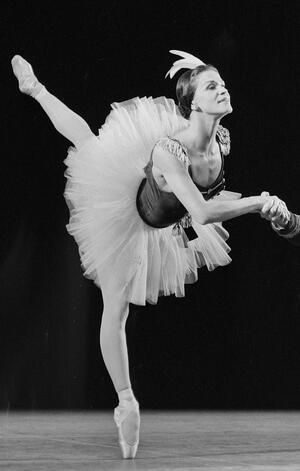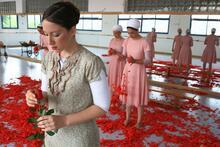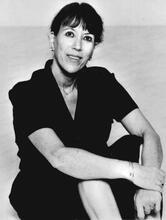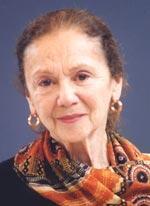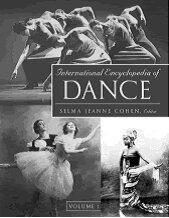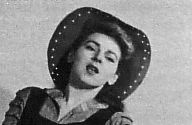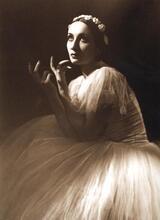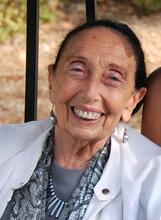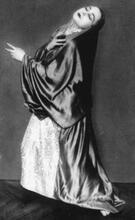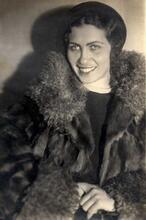Jewish Women and Ballet in the United States
Whether for economic, cultural, or political reasons, fewer Jewish women went into ballet than into modern dance. A number of Jewish women, however, became well known in the field of ballet. Those interested in ballet studied with gentile classical teacher-choreographers, such as Mikhai Fokine, Michael Mordkin, and Adolf Bolm. They performed in the main ballet companies, including the American Ballet Theatre, the Metropolitan Opera Ballet, George Balanchine’s New York City Ballet, and even Radio City Music Hall’s ballet company. An unexpected outcome of the popularity of ballet study in American by the 21st century is its influence in a wide background of American childhoods, including children of Orthodox Jewish communities.
Article
At the beginning of the twentieth century, audiences sought out ballet for its beauty and its grand reflection of elite European culture. Whether for economic, cultural, or political reasons, fewer Jewish women went into ballet than into modern dance. Those interested in ballet studied with gentile classical teacher-choreographers such as Mikhail (Michel) Fokine, Michael Mordkin, and Adolf Bolm in the 1910s and 1920s and performed in the main ballet companies, including the American Ballet Theatre (ABT), the Metropolitan Opera Ballet, George Balanchine’s New York City Ballet, and even Radio City Music Hall’s ballet company.
Mikhail Fokine moved to NYC and trained many Jewish students in the 1920s, including Nora Koreff (later Nora Kaye), Esther Rosen (who danced in the Radio City ballet company), Annabelle Lyon, Betty Eisner (renamed Betty Bruce, a star in Broadway shows), and Anne Wilson Wangh. During this time a group of Jewish workers who practiced acting in the evenings and were members of the Artef Theatre took classes with Fokine as part of their theater training (Graff 27). Some of these students were later recruited by Edith Segal to participate in her dance performances.
Anne Wilson Wangh (b. 1918-c. 2012) wrote about her memories of studying with Fokine. Many Jewish mothers who, like Fokine, were immigrants from Russia, were steeped in ballet. Wanting their daughters to be cultured, they enrolled them with the master. Wangh remembers Rosa Feldman, who went to the Metropolitan Opera as a dancer, and Miriam Weiskopt, who became a teacher of the Fokine style. After performing with ABT, Wangh choreographed her own programs, became active in the National Dance Guild, and started the Israel Dance Library with Yemmy Strum, a noted teacher of children in New York. Both women moved to Israel and were active in the Israel Dance Library organization. Wangh later returned to New York, where she continued her volunteer work for the library.
Nora Kaye née Koreff (1920–1987) was the daughter of Louise, a milliner, and Gregory, an actor with the Moscow Art Theatre who had worked with Stanislavsky. Her first studies in ballet were with Alexis Koslov and Margaret Craske at the Metropolitan Opera Ballet School and then with Mikhail Fokine, also dancing in the corps of his 1935 ballet company. Later she studied with Adolph Bolm, Bronislava Nijinska, and Anton Dolin. As a young girl she appeared in Metropolitan Opera productions when children were called for, including William Tell and Respighi’s Le Compana Sommersa. In 1935, while George Balanchine worked as ballet master, Kaye became a member of the Metropolitan Opera corps de ballet. She appeared in the Broadway musicals Great Lady and Stars in Your Eyes and in 1952 in Two’s Company, which starred Bette Davis. In 1938 she performed at Lewisohn Stadium and danced in the ballet at Radio City Music Hall. In 1940 she was one of the founding members of Ballet Theatre (later called American Ballet Theatre). She received critical notice for her role in Antony Tudor’s Lilac Garden or Jardin aux Lilas. By 1942 she was considered the premiere interpreter of Tudor’s works, starring as Hagar in his Pillar of Fire; the next year, she starred in Tudor’s Dim Luster (1943). She was recognized as the new company’s leading ballerina. She performed in the company in two different periods: from 1940 to 1950 and from 1954 to 1959. In the interim period she danced in Balanchine’s New York City Ballet, performing in many of his ballets and also dancing the lead in the premiere performances of Jerome Robbins’s The Cage and Ballade. When she returned to American Ballet Theatre she was awarded a special title of “dramatic ballerina” for her acclaimed performance as Lizzie Borden in Agnes De Mille’s Fall River Legend. She also performed in ballet classics, including Giselle and Swan Lake. From 1977-1983 she was associate company director. Kaye danced in ballets choreographed by Herbert Ross (her third husband) including Persephone and The Dybbuk, created in 1960. Together they established a company, Ballet of the Two Worlds, which toured Europe and appeared in the Spoleto Festival in Italy. She retired from dancing in 1960, then assisted Ross directing musicals on Broadway and in Europe and later when he became a Hollywood film director. She served as executive or co-producer on seven of his films, including Nijinsky (1980) and The Turning Point (1978), starring many dancers from American Ballet Theatre (including Isabelle Mirrow Brown). Their last work together was the film Dancers, which she co-produced with Ross in 1986 in Italy.
Ruthanna Boris (1918-2007) received her early training at the Metropolitan Opera’s school of ballet and also studied modern dance with the major American modernists. In 1934 she became one of the first students at Balanchine’s School of American Ballet. She performed with American Ballet Theatre, with Balanchine’s early company, then with Balanchine’s Ballet Caravan, in Agnes de Mille’s Broadway productions, at Radio City Music Hall, at the Metropolitan Opera (1937–1942), with the Ballet Russe de Monte Carlo, as a guest artist with the New York City Ballet, and in 1956–1957 with the Royal Winnipeg Ballet. Boris was also an acclaimed ballet choreographer who made her name choreographing Cakewalk in 1951 for ABT. She taught at the University of Washington in Seattle from 1965 until 1983.
Judith Chazin (b. 1937) studied with Mikhail Fokine, Antony Tudor, Alfredo Corvino, and Margaret Craske; she performed with the ballet choreographer Robert Joffrey at Jacob’s Pillow when she was sixteen, danced in Agnes de Mille’s Broadway show Goldilocks (1958–1959), and in 1959 she joined the Metropolitan Opera Ballet as Principal Soloist, performing there until 1963; she also performed with New York City Ballet. (see more under Judith Chazin-Bennahum in Jewish Women Dance Educators and Writers).
Other Jewish American Ballet Theatre dancers included Muriel Bentley, Isabel Mirrow Brown, Annabelle Lyon, and Miriam Golden. Bentley (b. 1920-1999) attended the Metropolitan Opera ballet school, joined its corps in 1938, and then performed for more than fifteen years with ABT. Jerome Robbins said of her dancing in Goyescas that “we must have been something, two Jewish kids whose mothers had wanted high culture for them trying to look Spanish classical” (Jowitt 46). She also danced in Robbins’s Ballets USA Company and in his Broadway shows. Isabel Mirrow Brown (1928-2014) married fellow ABT dancer Kelly Brown. It is said her friendship with Nora Kaye became the basis for the film The Turning Point. Three of Mirrow Brown’s children were ABT dancers: Leslie Browne (after retiring she became a renowned teacher at NY Steps and for ABT), Elizabeth Laing, and Ethan Brown (ABT soloist from 1988 to 2004). Annabelle Lyon (1915-2011), trained by Fokine and at the School of American Ballet, was a charter member of the company; she was also in de Mille’s Broadway shows and in Balanchine’s first company, performing his early works including Serenade.
Miriam Golden, born in 1920 in Philadelphia, joined the company of her teacher Catherine Littlefield in 1936 and then ABT as a 1940 charter member.
Raya Keen was a ballet dancer with Radio City Ballet Company, organizing the first union membership for dancers there.
Tillie Losch née Ottilie Ethel (1904-1975) trained at the Vienna Imperial Ballet School, performed and also staged dances in Max Reinhardt productions including The Green Flute, Jedermann, and Danton’s Death; she became adept at blending modernist movements with ballet. She came to Hollywood in 1931 to partner Fred Astaire in The Band Wagon; other film appearances included The Good Earth, The Garden of Allah, and Limelight. She also choreographed Duel in the Sun. She traveled back and forth to Europe, appearing in Paris with the George Balanchine production of Brecht and Weill’s The Seven Deadly Sins as part of the 1933 Les Ballets season. She also had featured roles in other Balanchine works including Errant and joined the Ballets Russes de Monte Carlo at his invitation.
Other Jewish dancers in America who performed for Balanchine included Melissa Hayden (1923-2006), daughter of Jacob Herman and Kate Weinberg Herman, Jewish immigrants from Russia to Canada. She danced with the Radio City Music Hall Company and then with American Ballet Theatre before joining Balanchine’s New York City Ballet in 1950, retiring in 1973. She taught at Skidmore College and then for 23 years at North Carolina School of the Arts.
Allegra Kent née Iris Margo Cohen (b. 1938) joined the New York City Ballet in 1953 and became one of the principals before retiring in 1978; she was especially known for her roles in Jerome Robbins’s ballets. She had trained with Bronislava Nijinska.
Barbara Milberg Fisher, who was in the original cast of Balanchine’s Agon, wrote a memoir of dancing for him called In His Company (Wesleyan University Press) and became chair of the department of literature at CUNY.
Pamela Osserman (b. 1951) studied in New Jersey with Joan Wolf (also Jewish, who had several dance studios in Bergen County, New Jersey) and in New York with Richard Thomas and Barbara Fallis, David Howard, and Marian Horosko at the Joffrey Ballet. In the summer of 1972 Osserman auditioned for the Israeli ballet dancers Hillel Markman and Berta Yampolsky who brought her to Tel Aviv as their main soloist for their new HaBallet HaClassi, sponsored by Israel which became the Israel Ballet Co. Osserman performed with them from 1973 to 1981, including on their American tour in 1974.
Toni Sostek (1937–1996), who trained at the Ballet Russe and ABT schools in New York, performed on Broadway in the 1950s and taught ballet at St. Olaf College and Carleton College in Minnesota from 1971 until her death. In an interview before she died, she said she believed that because ballets are filled with fairies, nymphs, castles, princes, and romantic stories, the dance form had less appeal for American women than modern dance with its messages of strong emotions, socially relevant concerns, and independent thinking.
Barbara Weisberger (b. 1926) was a student of Marion Horwitz Lehman and then the first child to study with George Balanchine at the newly formed School of American Ballet. In 1962 she founded and directed the Pennsylvania Ballet, for which she also choreographed. She went on to direct the Carlisle Project from 1984 to 1996, to help develop ballet choreographers.
Irina Pevzner Yacobson (sometimes spelled Jacobson) (1924-2018), a Soviet-Russian dancer and teacher, was the living index to the remarkable archive of radical ballets for the Kirov and Bolshoi Ballets made by her husband, Leonid Yacobson, the only Jewish choreographer during the Stalinist period. A former soloist with the Kirov Ballet, Yacobson was the last protégée of the legendary ballet teacher Agrippina Vaganova. After the death of her husband, she taught in California from 1987 to 2000 in the school and company of San Francisco Ballet, serving as Associate Teacher to director Helgi Tomasson; she also restaged Yakobson’s Rodin and Vestris ballets for the company. She was in demand in the West to teach the Russian ballet style and to stage Yakobson’s ballets
Nina Youshkevitch (1920–1998) trained in Paris in the 1920s with Olga Preobrajenska and Leo Staats. In 1934 she joined first the Opera Russe à Paris (formerly the Original Ballets Russes de Monte Carlo of Colonel de Basil), next Bronislava Nijinska’s Theâtre de la Danse in the mid–1930s, and then the Polish Ballet in Warsaw under Nijinska’s direction. She created roles in Nijinska’s ballets, including her Chopin Concerto. Nijinska invited her to the Hollywood Bowl, thus providing her escape from the Germans. In the United States Youshkevitch danced at the Jacob Pillow’s Festival, in the Metropolitan Opera Ballet, and in Felix Sadowski’s company. She taught for many years in her own studio in New York and also for Nijinska in Hollywood. She revived Nijinska’s Chopin Concerto and Bolero for the Oakland Ballet.
Rochelle Zide-Booth (b. 1938) performed with the Ballet Russe de Monte Carlo in the mid-1950s, achieving the rank of soloist. She was a principal dancer with the Joffrey Ballet, served as artistic director of Nederlands Dance Theater in 1973, and has been a dance professor at Adelphi University and Butler University in Indianapolis.
By the 21st century, an unexpected outcome of the popularity of ballet study is its influence in a wide background of American childhoods. According to Ballet Class: An American Study, ballet is popular in Orthodox Jewish communities, too. Girls in the most religiously stringent denomination of Judaism “enroll at regular community studios” and also in studios that serve an exclusively Orthodox Jewish clientele “in major centers of American Orthodoxy such as New York, Baltimore, Chicago, the Washington, DC suburbs and Los Angeles …[T]he inclusion of ‘tznius’ [Hebrew for ‘dignified modesty’] links the highly gendered core value from within Orthodox Judaism to ballet.” According to Klapper, this fits the Orthodox view of proper behavior for girls, in addition to approved benefits that ballet study provides such as “coordination, energy, self-expression and an outlet for emotion” (Klapper, 305-306).

